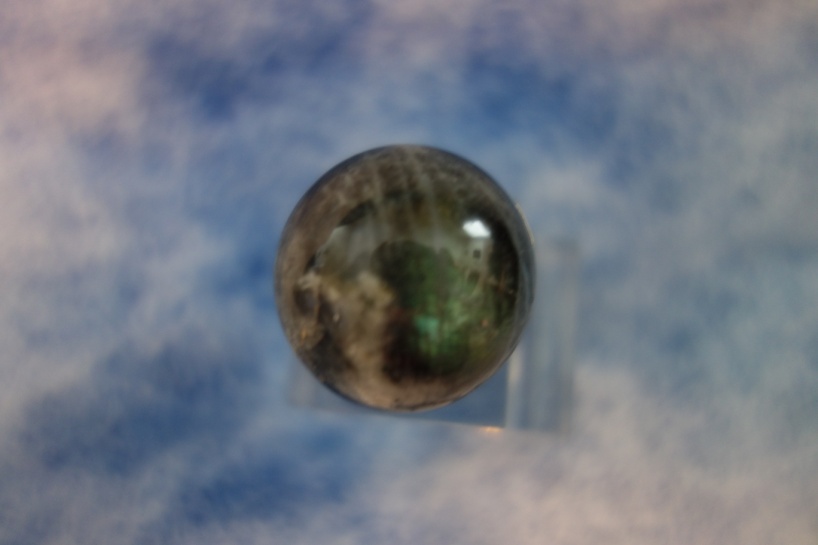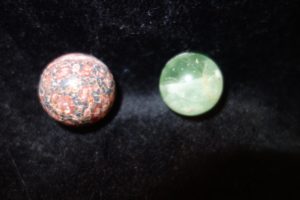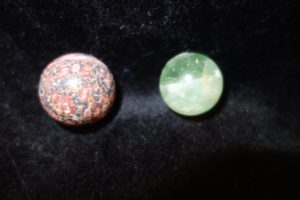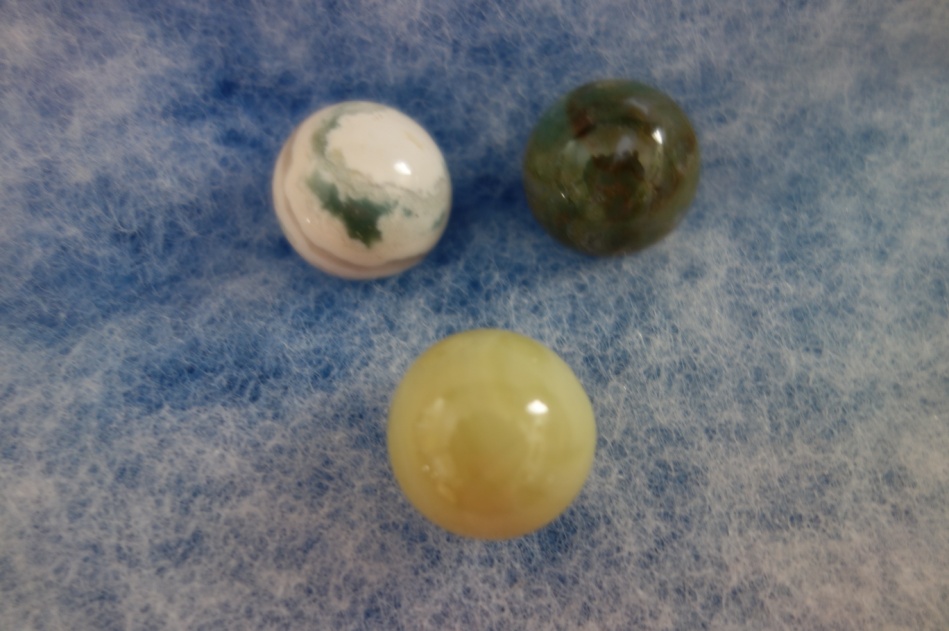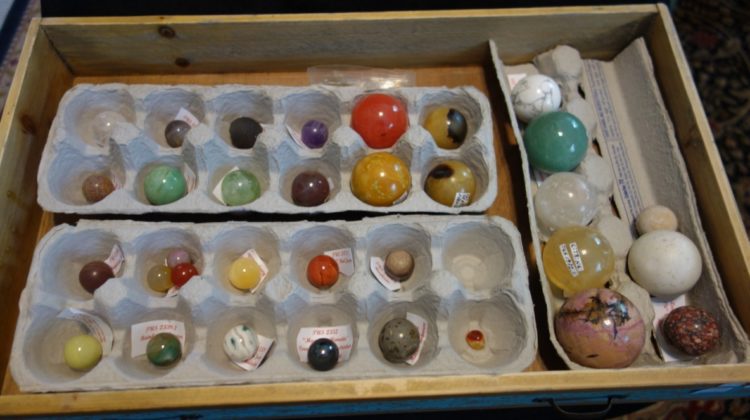
A Look Back Over Our Shoulder …
Awhile back in the post Rock & Roll: How to Store and Show Your Marbles we talked about our fascination with rocks and minerals. This fascination with rocks, minerals, gemstones, and stone artifacts is much older than our marble collection.
In the Rock & Roll: How to Store and Show Your Marbles post we wrote: “Now we have 150 different rocks, minerals, and gemstones. Ever heard of “Yooperlite”? We have an orb of it. White Phosphorus, Turquoise, Aqua Aura Quartz, Marble, Speleothem, Pipestone, Mookiate, Girasol Gemstone, Flint, Cave Cobble? We have at least one sample of each. Yes, we admit, some are not ‘marbles’ in the most narrow definition. But some are.”
Over the years we have collected minerals and gemstone orbs in sizes which roughly correspond to our glass marble sizes. We really like the ⅝”, shooter size of about ⅞” to one inch, and as you can see in the feature photograph above, a few up to three inches. Somewhere over the years we have learned to accept glass marbles up to a maximum three inches and we know, just as one example, that Sam Hogue has made some gorgeous art glassmarbles this size.
So, Why have We Not Published About Mineral Marbles Before?
There is divided sentiment on what constitutes a marble. While we collect spheres within the accepted size range in almost any material (including wood!), the position on mineral marbles within the Marble Collectors of America differs.
“There are many Mineral spheres available. Most of these are not true marbles, but merely minerals in the spherical shape. Almost all are modern. Some marble collectors add these to their collections because they display well. However, most of these were never intended to be used to play the game of marbles, although some were produced to be used in solitaire-type games.”
But, like any number of other things that we have discussed lately in this eMagazine, we finally decided that minerals are way too much fun to collect and learn about not to discuss a few of ours in some detail.
Also, there is simply no good reason to ponder and puzzle about whether or not a mineral or gemstone is old and planar or whether it was gangue right off mining tailings deep in Amazonas, Mina Gerais, or Fès-Meknès.
Rocks, Gemstones and Minerals
Ok, let’s not get all tangled up here. We hope that we have established that if you like it then collect it, show it, learn about it. But it’s also fun just to know what you havet! So a few definitions are in order.
The British Geological Society tells us that a rock is a solid collection of minerals. And gemstones, like diamonds and zircon, are minerals which may include other minerals.
Our National Park Service tells us that “minerals are formed naturally by geological processes. A mineral is a homogeneous solid that can be made of [a] single native element or more usually a compound. Minerals make up earth’s rocks and sands, and are an important component of soils.”[1]
Metaphysics
Since we started collecting minerals and crystals as adults we have been aware that there are a couple of different paths which collectors take. On the one hand some collectors emphasize that minerals and crystals have metaphysical properties which can heal the human body.
There are chakra healing stones. And some scholars trace crystal healing practices back some 6,000 years to Sumerians in Mesopotamia. There are New Age websites and shops and shelves of books on a wide variety of topics. A good place to start is ForbesHealth[2].
The Die Is Cast
We didn’t take the metaphysical path. Certainly, we have had some improbable “alternative” friends over the years who taught us a lot. And we’ve had some remarkable cross-cultural experiences while living in the Middle East for almost a decade.
And we have had some metaphysical experiences which were torn from the pages of National Geographic while afoot in Southeast Asia. But one thing which has always held us back is the simple fact that there is so very much to learn in this field.
Even if you don’t subscribe to metaphysical philosophy please don’t dismiss their mineral shops. Some are astonishing! We always try and visit Daytona Books and Metaphysics (Florida) as just one example. These Spiritual shops have exceptional minerals, crystals, and gemstones.
Geology
One of the reasons that we are more comfortable with the geologic approach is that we both collected and studied rocks and minerals, both cultured and natural, as children. We also studied the subject in college.
We have belonged to a rock and mineral club and if you, too, are more into geology then you might want to check out such a local club. And don’t forget to check out local mineral shows.
Our go-to book for rock, mineral, and gemstone identification has always been Ronald Lewis Bonewitz’s Smithsonian’s Rock and Gem (NY: DK Publications, 2005).
One and Only
This mineral really is a marble! We bought this beautiful semiprecious silica mineral in Winter Haven, Florida, in November 2007. It is one of only two marbles which we have in our collection and which we have never seen another. The second one is amberina glass. But just look inside this agate at the odd green sheen!
Needless to say, the dealer had only one and he was not keen to let it go at any cost. He claimed it is an agate from New Mexico. We noticed, even in poor light in his shop, a strange green glow inside the marble. It reminds us of tiger eye, but agate doesn’t naturally have such an odd effect.
When we first saw it we were not positive that the marble was stone agate rather than glass. When we got home, we were still uncertain what we had.
An Unnatural Stone
However, Baumann, in Collecting Antique Marbles… 4th Ed. shines some light on the subject. In his essay ‘Agates’ he writes (Page 20):
“Agates are rarely encountered in colors foreign to natural stones, such as green or blue…. Agate is one of the semiprecious stones that can be colored either by dying or by heating, and these processes were known in the 1800s.
The processes for dying agate blue, green, or yellow (the rarest) were introduced in the mid-1800s, and dyed agates were produced into the early 1900s (Gartley and Carskadden, 1998)[3].”
Baumann continues:
“The finished product is really lovely, since the green or blue color is not a coat of paint on the surface, but penetrates the entire marble, replacing the previous color; such marbles are just as translucent after the coloring process as they were before (emphasis added).”
Agate: Not Glass
This is exactly what we have! The marble is green and white and translucent. This is agate. It is natural stone and not glass. It passes all of Baumann’s requirements: regular and concentric layers of color; concentric rings; and a fracture on one pole. Baumann explains that when a natural agate is hit it won’t chip. Rather it fractures below the surface.
He Knocked Their Socks Off!
We were thrilled to learn that it is agate, and even more excited to realize that it was owned and played with by a child. At a bit over 1” it is perfectly child-size. And that sub-surface fracture did not occur in a bag or jar. It happened when someone’s taw knocked the socks off somebody’s glassies!
Baumann goes on to explain that (Page 21):
“To verify an agate as antique, check the marble with a magnifying glass under good light. … If the marble is hand-ground stone, it will have small flattened facets in at least some spots on the marble.”
When we examined the stone with our 10X loop under good light we did find such planar surfaces, and sparkles of some sort which we had not seen before.
“Is It Real Or Is It Memorex?”
It is very real. It is a colored antique natural stone agate. It may, or may not, have come from New Mexico, but we are convinced the dealer believed that it did. And although we cannot prove it, we believe that it was heat treated[4] rather than dyed.
Rhyolite : Leopard Skin Jasper
In April 2011 we discovered a small fair in downtown Lakeland, Florida. We met a nice couple selling gemstones. The gentleman said that he had studied geology for seven years and had a Master’s Degree in the subject. We bought this 1⅛” Leopard Skin Jasper orb which is to the left in the photograph. Our orb has a few scuff marks.
The seller told us that the orb is rhyolite. Geology.com tells us that
“Rhyolite is an extrusive igneous [volcanic] rock with a very high silica content. It is usually pink or gray in color …. Rhyolite is made up of quartz, plagioclase, and sanidine, with minor amounts of hornblende and biotite. Trapped gases often produce vugs in the rock. These often contain crystals, opal, or glassy material.”
A vug: really? A vug is a small opening in a rock. These are often lined with crystals, and we have all seen them, for example, in geodes.
Explosive Volcanic Magma
Rhyolite magma does not make a typical lava flow. When the volcanic magma explodes fragments fall and congeal into rock layers forming Rhyolite[5].
In Old Mexico
The seller also told us that our orb, which is a beautiful red and brown specimen, comes from the mountains of Mexico. We know that red magma cobbles come from Sonora. Rhyolite is also found in Durango and in Casas Grande, Chihuahua.
Fluorite
This one inch orb, to the right in the photograph, is a gift from Larry’s sister Lynn G. Howell. She bought it at the Gatlinburg, Tennessee, Rock Shop in November 2007.
This interesting little mineral, which is full of fractures, facets, and impurities, is an example of mining gangue. It comes from zinc and lead mining tailings.
Gangue and Mineral Orbs
Regardless of which ore is being mined, once the valuable minerals are extracted the mine owners are left with tailings from which they can extract nothing else profitable.
This is called gangue, and sometimes it has been left in place for years. Recently, these spoils have been re-visited and some beautiful and interesting orbs have come on the market which were pulled from the dust and worked.
Fluorite is one example of this process and it is a mineral found in most rock and mineral shops. We have also found it in cube form.
Chalcedony, Jasper, and Quartz
Jasper has been given more names by collectors and dealers than any other mineral we know. Like fluorite, it is easily found on the market and you can have fun building a nice display of the thirty or so named types of Jasper.
But first, what is it? Chalcedony is a microcrystalline form of the mineral Quartz. This means that while solid the mineral is made up of minuscule crystals of quartz. Jasper, in all its amazing forms and colors, is an opaque form of Chalcedony.
It is impurities which give Jasper its many colors, and some collectors consider it a rock rather than a true mineral. Generally Jasper is red, brown, and yellow, but it is often seen in mottled green and even orange. Like Agate, some Jasper is banded. However, unlike Agate Jasper is, as noted, opaque[6].
Examples Using Collector Names
We are going to use collector names for these three 13/16” orbs of Jasper. Each is perfect marble size and would make wonderful shooters. We bought all three in a mineral shop in Blue Ridge, Georgia.
Ocean Jasper
Ocean Jasper is to the upper left in the photograph. This is one of the jaspers called orbicular. “Orbicular” simply means that it is banded or has circular ribbons of colored impurities such as iron or clay. These bands set this type jasper off: our bands are tan, green, blue, and clear on a white base. Remember, Jasper is opaque, but the clear band is crystalline.
Ocean Jasper is a registered trade name. This jasper is unique to the northwest coast of Madagascar where it is known as Kabamby Jasper for the district where it is found. We understand that it is now completely mined out[7].
Yellow As Buttermilk
The yellow marble in the middle bottom row is called simply Yellow, Butter, or Buttermilk Jasper by collectors. If you look around a bit in mineral shops and sometimes in antique stores you will find a wide variety of this mineral in a range of yellow and yellowish colors.
And if you can find this jasper in raw form you might be surprised that the yellow color appears slightly different from the polished orbs.
Evidently, the yellow color comes from clay. Yellow jaspers are found in Australia, Botswana, Italy, and in the United States.
Rainforest Jasper
Rainforest Jasper is a form of Rhyolite. This one has several planar surfaces. With so small and dark a stone it is difficult to get a clear view of the orbicular spots. However, if you look closely you can see the green and brown with blue spots. We can only imagine that it was called Rainforest because of the colors.
“Rainforest Jasper is a rare type of rhyolitic lava, associated with volcanic activity in some areas.” Unlike the explosive volcanic magma of the Leopard Skin, “gas bubbles are trapped in the lava flow during solidification, creating pockets which are later filled, or partially filled by flows of siliceous material, which may be Agate, Jasper, Quartz Crystal or other minerals.”
So, this Rainforest Jasper was formed in a lava flow.
“Rainforest Jasper is known in different parts of the world by several other names. These include Spherulitic Rhyolite, Agatised Rhyolite and Green Rhyolite. This unique gemstone is mined only at Mt Hay, 38 kms west of Rockhampton in Central Queensland. It was first mined commercially in the late 1960’s and continues to be a popular gemstone with cutters and collectors around the world.[8]”
Let’s Close the Mineral Drawer…
…At least for now. We hope that we have given you some ideas. Collecting mineral orbs is a fantastic hobby and it can be even more fun if you associate it with your marble collection. If you like non-glass marbles then the association of minerals and marbles is even more natural. If you already have a mineral collection, congratulations! Keep on hunting! And if you don’t, why not think about augmenting your marbles with minerals? Happy hunting!
- https://www.bgs.ac.uk/discovering-geology/rocks-and-minerals/ (4/6/2023) and https://www.nps.gov/subjects/geology/minerals.htm 4/6/2023 ↑
- Teresa Adele. “Healing Crystals: Benefits, Uses and Where to Buy.” ForbesHealth. https://www.forbes.com/health/mind/guide-to-healing-crystals/ ↑
- The paper which Baumann cites here is a classic on the subject of marbles found on archaeological digs. In full it is: Gartley, Richard and Jeff Carskadden. 1998. “Colonial Period and Early 19th-Century Children’s Toy Marbles: History and Identifications for the Archaeologist and Collector.” Muskingum Valley Archaeological Survey, Zanesville, OH. You might also want to check out: Carskadden, Jeff, Richard Gartley, and E. Reed. 1985. “Marble Making and Marble Playing in Eastern Ohio: The Significance of Ceramic, Stone, and Glass Marbles in Historic Archaeology.” Proceedings of the Symposium on Ohio Valley Urban and Historic Archaeology 3:86-96. University of Louisville; and, finally Carskadden, Jeff and Richard Gartley. 1990. “Chinas: Hand Painted Marbles of the Late 19th Century.” Muskingun Valley Archaeological Survey, Zanesville, Ohio. If you want to read a little more about heat treatment then check Following is Alberto Scarani and Paolo Minieri . “Heating of Precious Stones.” https://www.gemologyproject.com/wiki/index.php?title=Heat_Treatment (4/11/2023). “… A discussion of one of the most oldest methods for gemstones enhancement….” ↑
- It’s practically impossible to establish a precise dating of the first gemstones heating experiments. Red agates and carnelians revealing evidence of heat treatment were produced in India in 2000 B.C.; many examples were also recovered from Egyptian tombs, including treasures found with Tutankhamen (Circa 1300 B.C.). In more than 4000 years, the procedure hasn’t substantially changed! This will be apparent when you have a look at some elementary ovens that are still operational nowadays in the Chanthaburi area, Thailand and Cambodia (photo 1). These ovens still produce at full speed heated gems of nice quality. Alberto Scarani, and Paolo Minieri. “Heating Precious Stones.” https://www.gemologyproject.com/wiki/index.php?title=Heat_Treatment 4/12/2023 ↑
- https://www.sdnhm.org/exhibitions/fossil-mysteries/fossil-field-guide-a-z/red-rhyolite/ 4/11/2023↑
- You might want to check: https://www.minerals.net/mineral/jasper.aspx (4/11/2023) Also check Smithsonian’s Rock and Gem on page 229. ↑
- You might want to look over “Ocean Jasper Properties Facts and Photos” @ https://www.stonemania.co.uk/crystals/o/ocean-jasper 4/11/2023↑
- https://www.aradon.com.au/rhyolite-rainforest-jasper/ 10/14/2018↑

